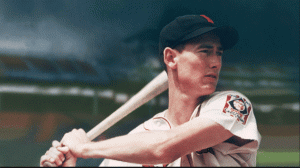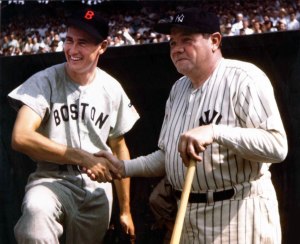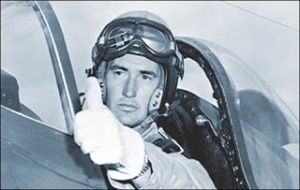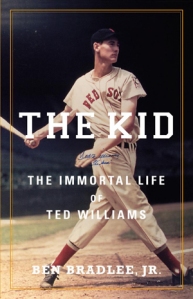Tagged: Bill Russell
Swing and a Myth…
Finding the Real Ted Williams
By: Scott Conroy
For a sports-obsessed kid like myself, growing up in what is arguably the nation’s most sports-obsessed city, Ted Williams’ very name conjured a mythic quality.
In the pantheon of historical significance, he placed somewhere between Joan of Arc and George Washington — and was just as unknowable.
I never saw more than a few seconds of archived footage of the legendary Red Sox left fielder in action, but I knew a few facts about the man, which were as ingrained in my mind as my own date of birth.
Williams was the last player to achieve a .400 batting average, which he pulled off during the 1941 season — a singular accomplishment in a sport that venerates individual statistics.
He hit a home run in the last at-bat of his 19-year career, every inning of which he played in a Red Sox uniform.
And, most importantly, Ted Williams was “the greatest hitter who ever lived.”
This laudatory and unnuanced appraisal was regarded — in my world, at least — as a matter of undisputed fact. Any peer who might have argued otherwise during an elementary school recess or a backyard Whiffle ball game would face ridicule as biting as if he had claimed that 1 + 1 = 3.
The Kid is the culmination of a decade-long effort by longtime Boston Globe reporter and editor Ben Bradlee Jr. to provide a comprehensive look at the man whose posters adorned his bedroom walls as a Boston-area child in the 1950s.
The result, an engrossing and exhaustively researched biography, applies plenty of ink across its nearly 800 pages in documenting Williams’ Hall of Fame playing career — the facts of which back up most of the legends about him.
While Bradlee eagerly touts Williams’ peerless attributes as the player who could hit for both power and average better than anyone in baseball history, he also engages in some welcomed myth-busting.
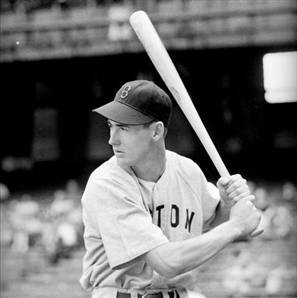 Among the Ted Williams “facts” that youth baseball coaches like to trumpet in batting cages up and down New England: his vision was so phenomenal that he could actually see the seams of the ball as it hurtled toward him at upwards of 95 miles per hour.
Among the Ted Williams “facts” that youth baseball coaches like to trumpet in batting cages up and down New England: his vision was so phenomenal that he could actually see the seams of the ball as it hurtled toward him at upwards of 95 miles per hour.
As it turns out, Naval doctors determined that Williams’ vision was 20/15 — an excellent mark that put him in the top 95 percent of young men his age, though not quite in the realm of superhero acuity.
Though Bradlee’s recounting of Williams’ career is candy for any baseball fan, The Kid shines brightest in detailing the paradoxical character, cinematic life and sad circumstances surrounding the death of the Splendid Splinter.
That Williams spent much of his life either hiding or downplaying his half-Mexican heritage is perhaps unsurprising given the biases that permeated his southern California upbringing and the segregated sport in which he became a star.
But the extent to which his ethnic background has remained obscured is striking. If one were to gather a roomful of passionate baseball fans today, I’d confidently wager that more than half would have no idea that Teddy Ballgame was among the first great Hispanic ballplayers in the big leagues.
Bradlee is at his most compelling when detailing the circumstances surrounding 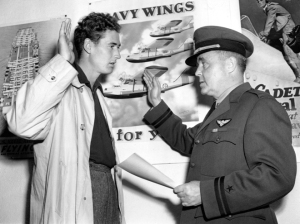 Williams being drafted into the Navy in World War II, just months after his .406 season — and a time when he was entering what should have been the prime years of his career.
Williams being drafted into the Navy in World War II, just months after his .406 season — and a time when he was entering what should have been the prime years of his career.
After originally being granted a Class 3-A deferment, on account of being the sole economic provider to his mother, Williams quietly asked his attorney to challenge the U.S. government’s decision to change his draft status to Class 1-A (available for unrestricted military service) — an appeal that the Selective Service rejected.
Williams’ initial attempts to avoid leaving the batter’s box for the cockpit were catnip for Boston’s aggressive newspaper reporters in the post-Pearl Harbor patriotic melee. In the months before he reported for duty, he received a bevy of letters in support of him and more than a few that questioned his courage.
One unidentified heckler mailed the All-Star left fielder two sheets of blank yellow paper — a message intended to remind Williams of the color of cowardice.
“I’ve noticed that the mud-slingers border on the illiterate side,” the famously prickly Williams, who often viewed himself as a victim of overly aggressive media, said at the time. “The encouraging letters come from well-bred persons.”
Once he reported for duty, Williams took the hard road — becoming a commissioned second lieutenant in the Marines Corps. He did not see combat over the Pacific — a disappointment for a man who, once he was on active duty, envisioned “downing a Zero” (a Japanese fighter plane) as something of an all-time life achievement.
Instead, Williams spent the last months of the war as the U.S. military’s most famous flight instructor in Pensacola, Fla., where he was somewhat of a ringer while playing for the base’s recreational baseball team.
After returning to baseball and eventually entering the latter stage of his playing career, he did not mask his fury over what he considered unfair treatment: He was recalled to fly combat missions over North Korea in 1952.
During his very first engagement of the Korean War, Williams’ fighter jet was hit by small arms fire. He considered ejecting, but fearing that a crippling injury would make his return to the diamond impossible, he made a daring emergency landing.
In all, Williams lost five of his prime playing years to military service — a fact that makes his final stat sheet all the more remarkable and that has long been a centerpiece in any discussion of his greatness.
After all, who could imagine a pro athlete in the modern era giving up all of the money and privileges of sports fame to serve his country?
Well, Pat Tillman may not have been a star approaching Williams’ caliber when he left the NFL to join the Army Rangers after the 9/11 attacks, but the $3.6 million contract the Arizona Cardinal safety turned down in favor of fighting in Afghanistan, where he gave his life, dwarfed Williams’ 1941 salary of $30,000.
That’s not to say that Williams’ wartime service was any less honorable, but Bradlee details the extent to which it was initially reluctant.
A hallmark of Williams’ post-playing career was his generous charity work on behalf of the Jimmy Fund, Boston’s leading foundation for cancer research support — time and money that he insisted not be accompanied by media attention.
Bradlee’s painstaking efforts to recount the macabre details of the family struggle that led to Williams’ body being cryonically preserved after his death in 2002 are difficult to digest but nonetheless serve as an essential postscript to this “immortal life.”
 In 1993, Massachusetts Gov. Bill Weld was tasked with naming the long-awaited tunnel that would connect South Boston to Logan Airport — a major component of the epically over-budget Big Dig project that would finally modernize The Hub’s traffic-plagued highway system.
In 1993, Massachusetts Gov. Bill Weld was tasked with naming the long-awaited tunnel that would connect South Boston to Logan Airport — a major component of the epically over-budget Big Dig project that would finally modernize The Hub’s traffic-plagued highway system.
After determining that there were already enough public infrastructure projects named after politicians, Weld decided to honor one of Boston’s sports heroes.
There were several more-decorated local candidates from which to choose. No athlete in the history of sports, after all, is more synonymous with the words “winner” and “dynasty” than Bill Russell, who led the Celtics to an astounding 11 NBA championships during his 13-year career. And three-time consecutive NHL MVP Bobby Orr revolutionized the defenseman position during his 10 seasons with the Bruins and scored one of the most memorable goals in hockey history in clinching the 1970 Stanley Cup.
Ted Williams, on the other hand, slumped his way through his Red Sox’s only World Series appearance, in 1946, and never won the fall classic.
But then again, neither did Carl Yastrzemski, Jim Rice, or any of the other Red Sox greats who graced Fenway Park during the team’s infamous 86-year World Series draught.
greats who graced Fenway Park during the team’s infamous 86-year World Series draught.
Despite never having brought home the big one, no sports hero’s legend shines brighter in Beantown than the man who liked to be called The Kid. And so the cane-wielding 77-year-old was granted the honor of opening The Ted Williams Tunnel in 1995.
Even if that landmark must one day share valuable downtown real estate with Larry Bird Drive, The David Ortiz Parkway, or Tom Brady Bridge, Ted Williams’ mystique will remain unparalleled in Boston lore — and The Kid: The Immortal Life of Ted Williams is now the definitive biography.
Boston native Scott Conroy is the national political reporter for RealClearPolitics. Follow on Twitter @RealClearScott.
“Two Captains, One Destiny”
That was the tagline from Star Trek: Generations. One of the lesser Trek films but definitely the one which brought most Trekkies war of words in the Kirk versus Picard battle to a zenith.
Hypothetically, till we hear otherwise, Jason Varitek is gone.
 And hell, since were getting more questions than answers… let’s rock… I’m Bobby V., my first year at the helm, I’m psyched, nervous and in need of a team captain. Do I leave it to the veterans to guide the team? Do I not appoint, anoint or christen a new captain and just seize the role of Supreme Leader? Should I go with the highest paid perennial all-star and MVP candidate who works with a proven yet quiet determination? Do I look to the two-time World Series Champion, the most clutch Designated Hitter in the history of the team (who made a d!ck of himself during ‘the fallout’)? How do I not give a serious look at the stalwart, rugg
And hell, since were getting more questions than answers… let’s rock… I’m Bobby V., my first year at the helm, I’m psyched, nervous and in need of a team captain. Do I leave it to the veterans to guide the team? Do I not appoint, anoint or christen a new captain and just seize the role of Supreme Leader? Should I go with the highest paid perennial all-star and MVP candidate who works with a proven yet quiet determination? Do I look to the two-time World Series Champion, the most clutch Designated Hitter in the history of the team (who made a d!ck of himself during ‘the fallout’)? How do I not give a serious look at the stalwart, rugg ed and unwavering 3B who always seems to be somewhere on the MVP ballot? Or I do take the risk of getting a no holds barred tell it like it is in your face pint-sized MVP who is the first to arrive, the last to leave and has been consistently reminded he’s just too damn small to be in the major leagues. In the words of Stone Cold Steve Austin, “Oh Hell Yeah!”. Dustin Pedroia. Pedey may in fact be the baseball equivalent of SCSA, or for a modern-day wrestler, C.M. Punk. Both are guys who let their personal lives, struggles and feelings permeate their ‘characters’ and both are the wrestling equivalent of Kevin Millar. I’ll go to war with either ‘One-Five’ any day of the week and a doubleheader on Sunda
ed and unwavering 3B who always seems to be somewhere on the MVP ballot? Or I do take the risk of getting a no holds barred tell it like it is in your face pint-sized MVP who is the first to arrive, the last to leave and has been consistently reminded he’s just too damn small to be in the major leagues. In the words of Stone Cold Steve Austin, “Oh Hell Yeah!”. Dustin Pedroia. Pedey may in fact be the baseball equivalent of SCSA, or for a modern-day wrestler, C.M. Punk. Both are guys who let their personal lives, struggles and feelings permeate their ‘characters’ and both are the wrestling equivalent of Kevin Millar. I’ll go to war with either ‘One-Five’ any day of the week and a doubleheader on Sunda ys. Pedey was the loudest voice following the destruction of Tito Francona and the first we heard from following the confirmation of Bobby V’s hiring. Like Varitek, he’s a proven warhorse on the field and his voice and opinion obviously counts for something off it. For as much as Valentine is going to take the ‘pressure’ off the boys and make it an atmosphere where they can play… let’s remember that he’s there because the last manager made it too comfortable. If we’re supposed to believe the reputation, Bobby is a diva… and should have a captain who can balance that image with one of his own.
ys. Pedey was the loudest voice following the destruction of Tito Francona and the first we heard from following the confirmation of Bobby V’s hiring. Like Varitek, he’s a proven warhorse on the field and his voice and opinion obviously counts for something off it. For as much as Valentine is going to take the ‘pressure’ off the boys and make it an atmosphere where they can play… let’s remember that he’s there because the last manager made it too comfortable. If we’re supposed to believe the reputation, Bobby is a diva… and should have a captain who can balance that image with one of his own.
Let’s look at the history of a few Boston Captains… Ted Williams was the best hitter of his and arguably any generation while also being a loud, foul-mouthed know it all with an ego the size of his home state and a hatred for the ‘Knights of the Keyboard’ to match. Captain Carl was a lifelong Red Sox who carried the respect of the ‘The Nation’ and quietly took the teams he was given on his Hall of Fame shoulders for a good deal of his twenty plus year career bridging the gap between Ted and Jim Ed. But, let’s look at a few other Bostonians to wear the ‘C’. Eddie Shore refused an anesthetic while a doctor sewed his ear back on. Bobby Orr, only the greatest hockey player to wear skates (sorry Wayne Gretzky lovers, but Wayne only played forward… Bobby played defense and dominated the all-around game) and he shared his captaincy with Bucyk and Espo for the most part. Ray Bourque was known simply as ‘The Captain’, a quiet yet powerful presence who led by example and had no problem putting himself before the team (except when he requested a trade due to his age and knowing the B’s weren’t going anywhere) nor did his alternate captain and Hall of Fame partner Cam Neely, a player of equal quiet ferocity who as president of the Bruins changed the landscape of the entire franchise and helped deliver the Stanley Cup. Big Z is in the same mold, with no fear of physically defending his teammates on the ice and setting the example in the locker room. Bill Russell, Hondo, Bird and Garnett… nuff’ said.
Sure, Varitek will in no way be an easy act to follow, but nor should he be. A team is a changing dynamic and requires someone who can change with it. That, if anything, would be the undertone of this off-season. Change and adaptation. Bobby Valentine is that change while Dustin Pedroia is the adaptation.
